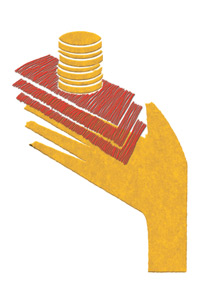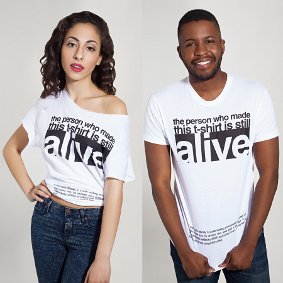 Note: This is the first of a series of 3 articles aiming at answering 3 different questions that all relate to the costing and retailing price structure of garments, not the least at the ‘fast fashion’ end of the spectrum.
Note: This is the first of a series of 3 articles aiming at answering 3 different questions that all relate to the costing and retailing price structure of garments, not the least at the ‘fast fashion’ end of the spectrum.
—

Recently, an interesting campaign piece was delivered to my mailbox: London based Offset Warehouse launched a capsule collection of T-shirts retailing at £4.99 (app. Euro 6, plus P&P).
While not made of Fairtrade or organic cotton (which would have tacked on another 50 pence approximately), the T-shirts indeed had been certified by
- WRAP (Worldwide Responsible Apparel Production; certificate no: 10022),
- REACH (Registration, Evaluation & Authorisation of Chemicals; certificate no: 26219),
- Sedex (Supplier Ethical Data Exchange), and
- Control Union (a global network of inspection operations).
Now, the point is, that even if these T-shirt were sold through a major retailer, they would hardly have retailed at more than £10 – and this at a vastly superior quality then is often case.
The whole campaign raises a few important questions:
- What is the typical markup of a retailer in the UK (or Europe for that matter)
- What do we know about how garment costs is broken down across the supply chain, and
- What of all that are buyers aware of, and how do they use it?
I will try to answer all three of these questions in this post, in accordance to what research says. As usually, I will include the links to publicly available papers or articles where ever possible.
What is the typical markup of a retailer in the UK (or Europe for that matter)
Throughout 2012, Chris Carr (then professor at the School of Materials at the University of Manchester, now with The Clothworkers’ Centre for Textile Materials Innovation for Healthcare at the University of Leeds ) researched common mark-ups in the UK retail landscape. This research was done in the context of a feasibility analysis of side conditions and implications of bring textile and apparel manufacturing back to the UK. He then presented the results at the Symposium ‘The international textile and fashion industries: challenges and opportunities‘ that took place in October 24 and 25 in Prato, Italy, and which was organised by Monash University’s Prato Campus.
During his research, Carr found the followin typical mark-ups applied on average:
- Basic Round Neck Cotton T-Shirt: 200 per cent
- Denim Jeans: 400 per cent
- High-Value Shirt: 600 per cent
For fast fashion that means – knowing that these retailers do not trade in ‘high-value shirts, but very much so in the first 2 categories – that we can assume with some certainty that the mark-ups they apply are anywhere in the range of 200 per cent and 400 per cent.
For the remaining two questions, the most insightful research with surprisingly hard data, has been published by Prof. Doug Miller from Northumbria University in Newcastle. The two most relevant papers in this context are: ‘What price a living wage‘ and ‘Towards Sustainable Labour Costing in the Global Apparel Industry‘.
The insights provided in these papers, and the answers to the remaining two questions, will be developed in two upcoming post, each of which will be dedicated to answer one of the above questions.
—
Note: This is the first of a series of 3 articles aiming at answering 3 different questions that all relate to the costing and retailing price structure of garments, not the least at the ‘fast fashion’ end of the spectrum.

